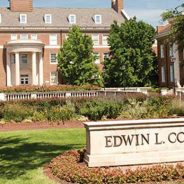Search results for :
Northeastern Professors Talk Dangers of Aetna-CVS Mega Merger
A recent multi-billion dollar mega-merger between health insurance company Aetna and popular medical dispensary chain CVS Heath has certainly raised some eyebrows, of which include several healthcare experts at Northeastern University and the D’Amore-McKim School of Business.
The QS World MBA Tour Is Coming To These Select Cities
There are few better opportunities to learn about the exemplary business school opportunities than at an MBA fair. And luckily, for many prospective MBA students, that opportunity will soon be arriving in their city with the QS World MBA Tour.
How to Master the Letters of Support on Your MBA Application
While business schools require candidates to submit anywhere from 1-3 recommendations as part of the regular admissions process, we’re devoting this admissions tip to a lesser known relative of the formal recommendation: the letter of support. The letter of support is very different from a typical letter of recommendation, in ways that we will detail below. In fact, we’ll use this admissions tip to share the following information:
• What is a letter of support?
• Who can author and submit such letters?
• When should a letter of support be submitted?
• What should a letter of support cover in terms of content?
• Should I seek out a letter of support at my target schools?
• How many letters of support should I seek out?
So without further ado, let’s dive into this lesser known element of the MBA admissions process.
What is a letter of support?
A letter of support is a short document (1-2 pages in length) that is submitted on behalf of an applicant by a third party – often without any involvement from the candidate. The letter is addressed to the director of admissions and seeks to make a case for the applicant’s candidacy at a given school. In many respects, a letter of support is really just an informal letter of recommendation.
Who can author and submit a letter of support?
Letters of support typically come from any one of three sources:
- Students at the school to which you applied
- Alumni of the school to which you applied
- Faculty of the school to which you applied
These are the stakeholders of the institution, and as such, have a voice in the campus community that the admissions team is open to engaging. The logic is that stakeholders in the school community should naturally seek to positively influence the outcome of admissions decisions (e.g. they should want the best and brightest to join the community of which they are a part) and that they will speak up (via a letter of support) if an exceptional candidate they know has applied.
When should a letter of support be submitted?
Most letters of support are submitted after the candidate in question has applied – usually within 2-5 weeks of the application submission date. The reason these letters should not be submitted prior to the candidate’s application is because it creates an extra hurdle for the admissions team – they can’t ‘match’ the letter to a file in their system until they actually have the application. It also makes sense, from a timing perspective, for the letter to come in after the application so that it can provide a bit of color commentary – or even a last word – on the candidate.
What should a letter of support cover in terms of content?
The key narrative should be about your fit with the school. The author of the letter does not need to follow the questions the school asks of the required recommenders. Schools are always interested to learn about how a candidate would integrate into the learning community of the program – and a supplemental recommender should be able to address this, through the lens of her own experiences with the school and with you. The more heartfelt and detailed the recommendation, the more useful it will be to the admissions team. A few sentences won’t make much of an impact, but a page or two that brings the applicant’s background and personality to life will signal that the writer really cares about your candidacy.
Should I seek out a letter of support at my target schools?
This is a question that many candidates ponder. The answer is that it depends on whether or not you know of someone who qualifies to submit such a letter (e.g. a student, alum or professor at the school) AND who knows you well enough to write a supportive and illuminating letter. Of course, you will also want to take into account a given school’s policy on such letters (more on this below).
Beyond whether you should seek out a letter of support, it is also worth considering what you might do if someone offers to write a letter on your behalf. Some schools actively encourage their stakeholders to offer informal recommendations (letters of support) for candidates they know. These schools may even have a process in place to solicit such input. Engaging with alumni, students and faculty in this way can also become an effective marketing tool for the school, allowing the members of their community to actively reach out and shape the next generation of MBA candidates.
Of course, some schools actively discourage any additional materials, post application. So if you are going down this path, then you should take into account the individual school’s policy for additional materials post-application submission. Of course, even in cases where a school tells applicants not to submit anything once their application is ‘in process’ it can still be fair game to a) have a supplemental recommender provide a recommendation prior to submitting your application, or b) if a member of the school community submits a letter unbeknownst to you. Of course, in the case that such a letter comes in prior to your application, you may find that it is harder to ‘match’ that letter to your file (as we indicated earlier).
How many letters of support should I seek out (if any)?
In most, if not all, cases, a single letter of support (per school) is sufficient. The risk of soliciting multiple letters is that it might suggest a ‘letter writing campaign’ (with the applicant overtly attempting to pull strings) and may not be welcomed by the admissions committee.
A Final Thought
For those who are unable to gain a letter of support from a stakeholder of the school, don’t panic. While this type of letter can help a school learn more about fit, the majority of candidates will not have this type of informal recommendation – and schools work hard at being fair to candidates with varying degrees of access to their school during the admissions process. As always, there are many other aspects of a candidacy that the school considers before making an admissions decision.
This article has been edited and republished from our sister site, Clear Admit.
Choosing the Best MBA: Philadelphia vs. Washington DC
On the surface, cities like Philadelphia and Washington DC appear to have a lot in common. Both have occupied roles as a center of U.S. history, and have transformed into exciting and ever-changing metros for both established businesses and new startups. If you’re interested in earning an MBA in a top metro area on the East Coast, it might seem impossible to choose between the two.
Even so, Philadelphia and DC offer a number of exciting—but different—kinds of opportunities for up-and-coming business professionals. Between what program you want to pursue and what kind of career you envision yourself in down the line, understanding the differences between top metros can be a crucial part of planning your future. Below, we’ll break down some of the biggest differences in location, programs, and job placement for each metro.
Philadelphia vs. Washington DC: The Differences
For ambitious business students hoping to put their education to work in a government agency, it’ll be hard to beat the nation’s capital for opportunities and experience. Even for those looking outside of the government setting, the DC metro area is home to fifteen companies on the Fortune 500 list, including corporate giants like Exxon Mobile and Walmart. Yet while such heavy hitting companies in the area provide a high earning potential, MBAs will still want to consider the high price of living in DC: currently, the city ranks as the third most expensive place to live in the country.
Check This Out: Searching for the World’s Top MBA Recruiters: Comcast
While Philadelphia may not be the city that pops into your mind as a bustling center of business, research shows the City of Brotherly Love can’t be beat when considering the job market and affordability: a 2016 survey from Adobo found that Philadelphia’s unemployment rate was 20 basis points below the national average, while the average price of a home was at or below 30 percent of the average income. MBA graduates will find no shortage of business opportunities in the city, even among major firms: in 2017, 20 companies in the Philadelphia metro made the Fortune 500 list.
Washington DC’s Full-Time MBA Programs
Featuring more than 35 higher education institutions with post-bachelor business programs, Washington DC is home to some of the top MBA programs in the United States. Fully aware that many of these programs will shape future politicians and government leaders, many of the MBA programs in Washington DC include a focus on integrity and ethics within the global business community.
Full-Time MBA Programs in DC Include:
- George Mason University School of Business
- George Washington University School of Business
- Kogod School of Business – American University
- University of Maryland R.H. Smith School of Business
- McDonough School of Business – Georgetown University
Philadelphia’s Full-Time MBA Programs
When it comes to business schools, Philadelphia is probably best known for The Wharton School at the University of Pennsylvania, consistently named as one of the top business programs in the world. But Philly is also home to a wide range of programs with a variety of specializations. Programs like the full-time MBA at Temple University’s Fox School of Business also offer students to take their education beyond Philadelphia, with international campuses based in Italy, London, and Japan.
Full-Time MBA Programs in Philadelphia Include:
- La Salle University
- LeBow College of Business – Drexel University
- Villanova School of Business
- West Chester University
Cost of MBA Programs
Just as important a factor as cost of living, average cost for an MBA program is an important consideration when choosing where to earn your degree. As expected, top programs in both Philadelphia and Washington DC can come with a high price tag. The average cost estimate for one year at Wharton is $105,265, while tuition at DC’s Georgetown McDonough School of Business is $90,591. The average for each city, however, remains much for affordable: approximately $82,090 for programs in Washington DC, and slightly lower in Philadelphia—schools like West Chester even offer an MBA as low as $21,000 per year.
Job Placement and Salary
With so many incredible companies located in both Washington DC and Philadelphia, MBAs have the chance to earn top salaries that can go a long way in both cities. Depending on the position, MBAs in Philadelphia can make anywhere from $64,665 per year (as a financial analyst) to $104,186 per year (as a senior product manager). In Washington DC, the average salary for an MBA graduate is in the $80,000 range, with employees reporting yearly salaries of $74,758 (operations manager) up to $111,983 (marketing director).
Making Your Post-MBA Career with Visa Inc.
The race for superiority in the global electronic payments market is a heated one. Every major credit card company has pulled out all the stops to persuade consumers to embrace digital transactions as their primary payment method—and they are going to need all the help they can get. It’s one of many reasons why major companies like Visa are always recruiting MBAs.
Kogod Professor Explains 3 Cyber Security Misconceptions
Cyber crime costs the world economy about $445 billion every year. According to an industry risk analysis report from 2016, cyber risks ranked third out of the top business risks, already 12 places higher than in just five years ago. Needless to say, cyber security misconceptions become a major concern in the modern business world that needs to be addressed sooner rather than later. Continue reading…
Beyond Business School: Emory Goizueta MBA Alumni Make Waves
One of the key quality indicators of an MBA program is its alumni. By looking at a school’s alumni, you can get a sense of the kinds of individuals who are drawn to the program, the impact the program can have on your future career, and the type of network you’ll have access to. At Emory University’s Goizueta Business School, this network includes Nick Harris, the director of digital operations and optimization for United Airlines in Chicago, and Elizabeth Halkos, the chief operating officer at Purchasing Power, an e-commerce company that provides voluntary benefits programs to employers to help their employees improve their financial well-being.
Nick Harris — ’08 EvMBA
Nick Harris’ job is all about enhancing the online shopping experience for United Airlines customers. To do this, he spends his days studying the behavior of visitors to United.com, from using their smartphones to shop to purchasing a service bundle. He then looks at what the competition is doing to ensure that United Airlines keeps on top of the latest trends.
Talking about his job, Harris told Goizueta: “An average week for me usually involves looking at a wealth of information or data and trying to understand what types of hypotheses we can generate based off how customers are behaving or transacting with our channels.”
For example, one of Harris’ main tasks is ensuring that consumers can purchase products on the United Airlines app as easily as they do on a webpage using their smartphones or computer. He also has to keep up with what the giants of customer service—Google, Apple, and Amazon—are doing.
Harris told Goizueta that when these companies offer a new service or do something really intelligent, they set a new standard that United Airlines has to keep up with. “You’re not just competing against others in your industry; you’re competing for mind space and time with all of the other devices and apps that are on customers’ phones,” he says.
However, this can be difficult for a large company that’s nearly 100 years old, but that challenge is part of what Harris enjoys. Harris regularly partners with other product owners to enhance the digital experience, collaborating across teams to assess metrics together to identify opportunities to improve the overall United Airlines customer experience.
“One of the things that we’ve been doing a lot is looking at web analytics data and marrying that with transactional data. As a company, we have loads of transactional data, which is one of the things that I absolutely love about being at a company this size,” explains Harris.

Nick Harris
His interest in working for a company like United Airlines was one of the reasons that Harris chose Emory for his MBA. Prior to attending Goizueta, he was employed at a small tech firm and considering launching an investment group with a few friends. The problem was that Harris didn’t have the right tool set and background to succeed. So, he began to look into the Goizueta Evening MBA program.
“I felt it was worth the investment to go back to school and take the time to grow in a structured learning environment, in order to build that tool set,” he says. “This way I could evaluate our opportunities and learn the science of business.”
But, in the end, it wasn’t just the classroom experience that impacted Harris, it was the relationships that he built. In particular, his relationship with Professor Patrick Noonan led him to the airline industry. “We were talking one day, and Noonan says, ‘If you really like this work and you’re interested in doing optimization, you should think about the airline industry, given all of the work they do from a space revenue management standpoint,” remembers Harris. And the rest was history.
Elizabeth Halkos – ’01 MBA
As the chief operating officer at Purchasing Power, Elizabeth Halkos has a good deal of leadership experience, which was recently recognized during the 14th annual Stevie Awards for Women in Business. Halkos was praised for raising the bar professionally and as a teacher and mentor for young women looking to launch their own ventures. This and her other accomplishments led her to be named a Silver Award Winner in the “Female Executive of the Year, Business Services: 11 to 2,500 Employees – Business Services” category.
Since 2002, the Stevie Awards have honored women executives, entrepreneurs, employees, and the companies they run globally. Each year, more than 170 professionals worldwide come together on five specialized juries to nominate the top women and organizations across more than 60 nations.
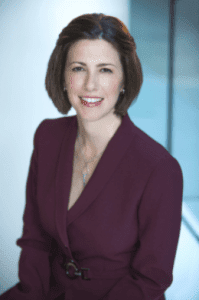
Elizabeth Halkos
After earning her MBA with a concentration in statistics and data analytics at Emory Goizueta in 2001, Halkos went on to work as a brand manager at Earthlink, Inc. and an account executive at Monster.com. From there, she served two years at the Inforte Corporation, where she consulted with such clients as Miller Brewing Company and Ocean Spray. Then, finally, she found her way to Purchasing Power in 2006.
Halkos started at Purchasing Power as the vice president of sales and marketing and quickly moved up the ranks. By 2010, she was promoted to chief marketing officer and then to chief revenue officer by 2014. In January of 2017, she was appointed to her current role of COO.
Halkos’s achievements at Purchasing Power include driving the top line revenue from $30M to more than $400M over a decade and helping the EBITDA (earnings before interest, taxes, depreciation, and amortization) grow from $5M to more than $40M. Most recently, she played an integral role in launching Purchasing Power’s 2017 rebranding campaign, which included new channel partnership strategies. This resulted in a 19 percent revenue and 80.5 percent adjusted EBITDA growth, compared to the same six months the previous year.
Halkos’s responsibilities at Purchasing Power include oversight of sales, account management, client services, customer experience, customer care, customer operations, business-to-business marketing, and public relations. She is also responsible for leading the broker and employer growth strategies for the company, which has helped Purchasing Power place on the “Inc. 5000 List of America’s Fastest-Growing Companies” for nine years in a row.
Outside of her job at Purchasing Power, Halkos is still very involved at Emory Goizueta. Since 2008, she has served as a board member, and previously served as president and vice president of the board. Recently, Halkos was also chosen as the recipient of Emory University’s “Annual Service Award” in recognition of her involvement in mentoring and supporting students at Goizueta.
To learn more about MBA alumni at Emory Goizueta, visit the school’s website.
This article has been edited and republished with permissions from our sister site, Clear Admit.
Harvard Reveals 5 New Years Resolutions You Can Actually Keep
You aren’t even a week into 2018 and are already regretting that gym membership, but, you still have time to refine how you want your year to look. Carmen Nobel at Harvard Business School Working Knowledge discussed some more “realistic” efforts you can take.
The Secret to Writing a Successful MBA Career Goals Essay in 2018
The MBA application essay is still the most feared part of most applications. Whether you have to write 1,000 words or just 500, saying everything you need to say in a concise, intelligent, and appropriate manner isn’t easy for everyone. In fact, it can be incredibly frustrating. And while every school asks different essay questions, there’s one question you’re almost guaranteed to see, “What are your short-term and long-term post-MBA career coals and how will School X help you achieve these goals?”
The career goals essay is one of the most common and also most difficult essay questions. On the surface, it seems simple, but there’s a lot of work required if you want to wow the admissions committee (adcom). It all starts with the question.
Breaking Down the MBA Career Goals Essay
Before you can write your career goals essay, you have to break it down into digestible and answerable pieces. There are six pieces to the career goals essay that you’ll need to consider before you begin writing.
1. Where are you now?
Before you can talk about your goals, you have to know where you are now and so does the adcom. This means that your essay will need to concisely describe your current position so that you can better explain your goals.
2. What are you short-term goals?
Short-term and long-term goals are not the same. Short-term goals refer to your immediate plans after graduation. Is there a particular industry where you want to work? Do you have a job or promotion in mind? Where do you see yourself in the immediate months post-MBA?
3. What are your long-term goals?
Long-term goals take a little more thought. You might not be as specific about companies or job titles when talking about your long-term goals, but that doesn’t mean you shouldn’t have a plan. Think about where you want the MBA to take you in ten or twenty years.
4. Why will an MBA help?
Next, you need to discuss how an MBA will help you achieve both your short-term and long-term goals. You’ll need to discuss technical skills, analytical skills, focus areas, and more.
5. Why is the School vital?
You need to make your essay personal. Not just any MBA should work for your goals. You need to explain specifically why School X is vital to your success. Get as specific as possible.
6. Why now?
Finally, you need to discuss why NOW is the best time to get your MBA and pursue your goals. Make a case for why this year, this class, and this moment are vital to your life.
Writing the MBA Career Goals Essay
Now that you know all the components of the essay, it’s time to start writing. To successfully answer the question, there are a few things that you need to keep in mind.
Be Specific
You need to be as specific as possible when answering each of the six parts of the question. MBA adcoms want to see that you have a specific direction in mind and that you have valid reasons for your choices. If possible, you should be able to specify your preferred industry, job function, skills, ideal company, and more.
For example: Talk about how you want to move into a career in Finance and gain a job at Goldman Sachs. Then, talk about how the MBA will help you gain technical skills in Finance and Accounting as well as analytical skills in Corporate Strategy and Strategic Planning. Finally, discuss how the case competitions at School X, as well as the MBA Finance Club, will prepare you for this career field.
Be Realistic
Adcoms want you to dream big, but they also want you to be realistic. There’s nothing impressive about an MBA career goals essay that describes a future path that is unreachable or illogical. Unrealistic goals will not serve to demonstrate that you’re ready for an MBA. Instead, you need to walk the fine line between thinking big and demonstrating that your career path has been well thought out and planned. Look up hiring trends, services, organizations, market status, and competitive concerns within your desired industry and companies.
For example: It’s okay to talk about your goals of managing a billion dollars, but you should indicate that this is a long-term goal, and you have a plan to reach it. Go step-by-step to illustrate that you know what it takes to reach your high aspirations by first talking about starting as a Finance Manager and slowly working your way up over twenty years.
Be Genuine
Adcoms can smell BS. You have to convince them that you are genuine in your interest of not just the MBA but of earning an MBA from School X. Take time to do your research and dig deep for those specific offerings from the program that will best serve you and your goals. If you can name specific classes, on-campus impressions, or information you’ve learned from alumni to demonstrate your genuine desire for an MBA, you’ll be in a much better place.
For example: Set up an interview to talk with an adcom or alumni before you write your essay. Then, during that interview, ask questions that will give you the information you need to beef up your essay. If you can talk about how an alum took the same career path and succeeded, you not only demonstrate your interest but your keen intellect.
Be Clear
Finally, make sure you write an essay that is clear and easy to read. Don’t worry about crafting the next great American novel. Instead, focus on answering the question as simply as possible and including all the necessary pieces. This is not a creativity contest. Instead, create a simple outline that you can fill out to answer the six components of the essay.
For example: You should write out the six questions (career analysis, short-term goals, long-term goals, why MBA, why School, why now) and come up with your answers separately. Then, once you have the outline and all the pieces, compile them together into a cohesive story. Don’t try anything fancy.
Stay up to date with more of MetroMBA’s vital essay and admissions tips here.
How To Break Into the Tech Industry: Intuit Inc.
Since 1983, Intuit Inc.—the Mountain View, CA software company that spearheaded the creation of products like TurboTax, Quickbooks, and Mint—has effectively changed the way the average person manages their money. And with more and more MBAs shedding their finance industry aspirations for a role in tech, a job with one of the most well-regarded tech organizations is looking especially ideal.
Why Should I Join Intuit Inc.?
Intuit Inc. was ranked 13th overall on Fortune’s 2017 list of the “100 Best Companies to Work For,” and 30th overall on Glassdoor‘s newest “Best Places to Work” list. The company takes a holistic approach to ensuring company well-being. Intuit has 24-hour onsite gyms, and even provides a certain amount of bicycles for employees who bike to work. Fortune listed job perks like telecommuting, compressed work weeks, college tuition reimbursement, daily free time to pursue other projects, and paid time off for volunteering.
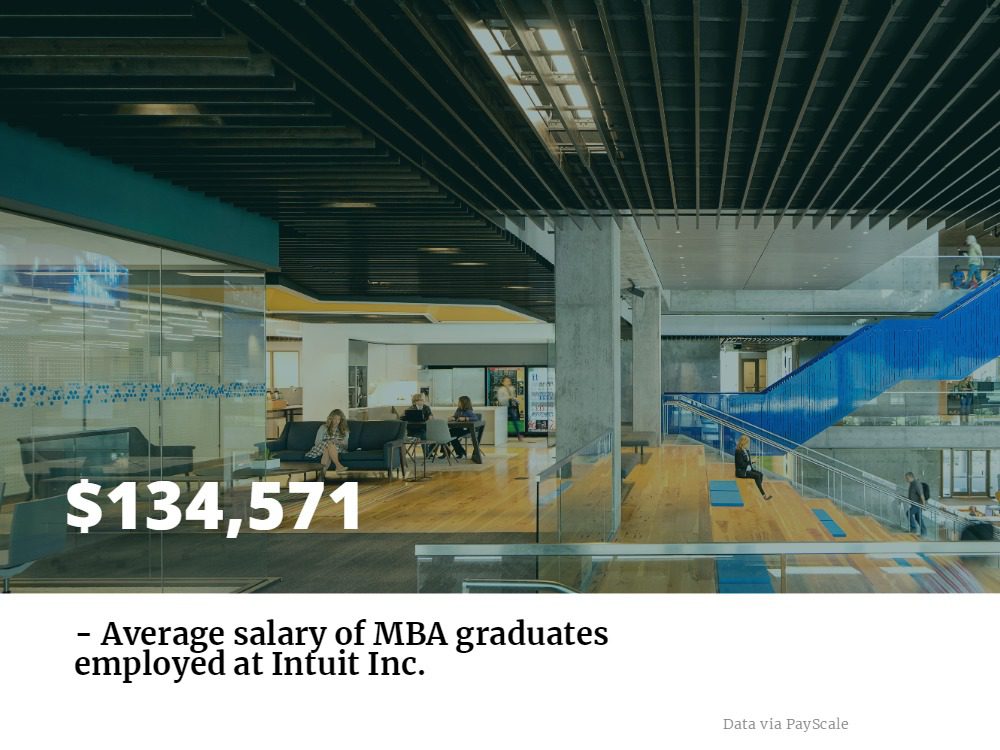
Many of the positions at Intuit are, unsurprisingly, tech-based, so an MBA may not be as advantageous in getting an engineering position. However, according to PayScale data, MBAs are typically the highest earners at Intuit, with the average MBA earning nearly $125,000 per year.
What Internships are Available?
Intuit Inc. has a specific internship for MBAs: the MBA Intern Marketing Manager position. This internship is offered in Intuit’s California locations in Mountain View and San Diego, as well as in Plano, Texas. In this position, MBAs help the company gain insight into the needs of customers and the effectiveness of current marketing strategies, through research and testing. According to the company website, these interns also have the opportunity to partner with teams working in, “Product Management, Development, Finance and Care.” This is a paid summer internship, so students can cover the cost of living while observing and contributing to innovations at a leading software company.
Intuit is currently offering a variety of other internship positions that might be appropriate for MBAs, such as a Marketing Intern position in London. MBAs specializing in Supply Chain Management can apply to be Supply Chain Specialist Interns, and work closely with Intuit’s Supply Chain Finance team.
At the company, it is not uncommon for intern’s to parlay their positions into full-time jobs after graduation. The company’s website says that its internship program, “is truly an ‘early identification’ program, focusing on identifying and investing in high potential university students really to encourage them in their early careers and potentially to bring their talent back to Intuit after graduation.”
How to Get Hired at Intuit
In recent years, Intuit has moved from a traditional interview process, to an innovative method of vetting candidates that incorporates virtual reality. Their hiring program, Assessing for Awesome (A4A), requires that candidates: “Speak for five minutes about themselves; speak for 15 minutes about two or three projects of which they’re proud; prepare a 15-minute presentation on a case study or coding exercise; participate in a 25-minute question and answer period.” The interview is conducted by an advanced staff member who works closely with the position in question. The company uses virtual reality to allow candidates to demonstrate their skill sets.
Intuit Inc. hires graduates and interns from a number of the top-rated business programs in the country, including the Northwestern University Kellogg School of Management in Chicago, Illinois, which brought in full-time employees and interns from the most recent graduating class. Some of the most highly-regarded MBA programs offer various tech industry advantages, including the recently introduced Tech MBA at NYU Stern, and the promising new Cornell Johnson Tech MBA, offered at the school’s new New York City campus.
For more information on which school’s provide the best opportunities to join the tech industry, head on over to our sister site Clear Admit, which recently took a look at programs from other established institutions like the UCLA Anderson School of Management and MIT Sloan.
What You Don’t Know About MBA Admissions Data Forms
As we approach the new year and many of our readers begin to work in earnest on their round two applications for the January deadlines, we would like to turn our attention to an oft overlooked element of the MBA application process: the application data forms. These forms—typically referred to as ‘data forms’ for short—are the online forms that one fills out when applying to a business school. While the forms used to be straightforward and brief (essentially amounting to contact information, academic information, and work history), they have been expanding in some areas and have become an increasingly important part of the mix of application materials. In the wake of an industry-wide reduction in the number of essays required by each school, many programs have actually shifted questions away from the essays and into these forms (as ‘short answer’ questions). As such, it is important to pay close attention and address the data forms early—and to avoid leaving them for completion on application deadline day. In fact, it can be rather dangerous to not give data forms the same amount of time and care you would afford any other component of your application.
In this tip we will address the commonly asked questions across all school’s data forms. For our next admissions tip, we will examine some of the more unusual questions asked by a few schools.
Contact Information
Schools need to communicate with applicants at various stages of the admissions process. It is important that they are able to do so, so the contact information questions address this issue. Most communication these days will occur online, so obviously the e-mail address is important. It is probably best to use a personal e-mail address, rather than a work e-mail address, so schools can continue to communicate with you once you have left your work. You should also make sure the e-mail address is appropriate, mrhunk@aol.com might not send the right signals. For those students who are admitted, a regular mailing address will be used to send out more detailed information in the form of an “admissions packet.” Often times, schools will ask for a current address, and a permanent address. These can be the same, but the difference will occur, for example, when a candidate is working on a temporary assignment.
Background Information
Schools will ask a set of questions to better understand your background. They will generally ask about your parents, specifically their employment status and their highest level of educational attainment. This can be meaningful for the admissions committees who might be seeking out those candidates who have achieved careers that are very different from the achievements of their parents. It also signals those who are first generation in terms of attending college. This may signal a candidate’s grit and determination. On the other hand, a candidate who has parents who are highly successful and went to elite schools may benefit from a bit of an “apple doesn’t fall far from the tree” bias. Some schools will also ask about siblings, partners and children.
The majority of schools also seek to learn if your relatives have connections with their program, or the wider institution.
Academics
The key to addressing the academics questions is to follow the specific directions of each school. They may want a PDF of a transcript to be uploaded of your undergraduate school record, or they may want all transcripts from all schools you have attended, whether for additional coursework, transfer credits and so forth. Most schools will ask for your overall GPA, and also will be explicit on whether to convert a GPA that is not on a 4.0 scale; the common rule in this regard is to not convert, and to identify what the scale is. Some schools ask specifically if you have covered course work in accounting, statistics, calculus and economics. These are not pre-requisites, but help schools identify your analytic skills. The majority of schools will ask for self-reported transcripts upon application and only require official transcripts after they have made an admissions decision, but some might ask you to bring those documents if you are invited to interview.
Work History
All schools will ask you to upload a resume. While some programs will be specific about the length of the resume, keep in mind that they generally prefer one page. Beyond uploading a resume, you will also be able to complete a work history section in the online application, where you enter each of your work positions. Most schools do allow a new entry for each new position, regardless of whether it is for the same company, a few require just one entry per employer. Each school will tell you specifically how it wants you to enter this data. For most schools you are asked a variety of questions, including beginning and ending salary, bonuses, and so forth. You should also have an option to complete your job function and role. This is a very important text box to complete with considerable thought. You will have a limited number of characters, usually, to establish your growth and impact. One or two schools do not have this option, which places more weight on your resume and essays. Schools will generally ask you how many years work experience you will have, at the time of matriculation, rather than the time of application. Some will also ask how many years of management experience you have.
Test Scores
All the schools we cover accept both the GMAT and the GRE tests. It is important to read the instructions for each school in terms of how to report your test scores. A few schools want to know all your scores, and may look at the individual breakdowns of components of the scores. A few schools also ask whether you plan to retake the test, after you submit your application, at least one school asks if you would retake the test if asked. Schools will also require a test for English communications for those who are not native English speakers (unless the language of instruction for undergraduate was English, in which case most schools will offer a waiver). While the TOEFL is the most commonly used test, there are also other tests that schools will use like the IELTS, so it is important to review the requirements of each school you are interested in.
Other Activities
Most, but not all schools will ask you about your activities outside of work, and your extra-curricular activities while you were an undergraduate student. They want to see if you are well-rounded, and seek to identify other passions you might have, that will make for a richer MBA learning environment for all. It is also a good place to show case additional opportunities for your leadership and ability to make an impact. Each school asks these questions slightly differently. Some schools ask about hobbies, some do not. Some schools ask you to list the most important activities in which you have been involved, forcing you to prioritize with a limited number, some schools have free-flowing text boxes for you to answer the questions. One school does not ask about these activities at all, but their instructions for the resume clearly state to include them in that document. Regardless, it is important to read directions carefully, and consider your application in a holistic manner.
Goals
Probably the biggest shift in the use of data forms in the last few years is the increasing use of this medium to examine your career goals. You may be asked about your short-term goal (e.g. your career path directly out of the MBA program) and some schools also ask about your long-term goal (the position you would like to hold 5+ years after earning the MBA). A few schools will also ask for an alternative short-term goal if your preferred goal does not work out. Addressing these questions with considerable thought will be crucial. Schools really want candidates that have thought thoroughly regarding why they are applying. Some school have stopped asking these questions in the essays, so they rely on the data form answers.
Marketing questions
Finally, a few schools use the data forms to understand how you first learned about the program, and what other marketing events you may have attended. They might also asked who you met and know, from the school, during the process of putting your application together. If you have developed a network of alumni at the school and these questions are being asked, make sure you highlight who they are. Much like the questions for background information, any time you can highlight your connections to the school can only be an advantage.
For our next admissions tip, we will explore more of the unusual questions that a few schools ask in their data forms, which cover issues like the feared “To which other schools are you applying?” as well a move to ask more internationally focused questions.
This article on MBA Admissions Data Forms has been edited and republished from our sister site, Clear Admit.
Check out more MBA admissions advice you cannot miss here.
What Is Your 2018 MBA Resolution?
For those who aren’t in a post-New Years Eve hibernation, 2018 is here, and that means actually following through on all those promises you hastily made an hour before the year officially began—including your 2018 MBA resolution.
You and every other person in a five mile radius will pack your preferred gym for the next few weeks, dutifully following through on the promises they made themselves. And while the frustration of waiting, waiting, and still waiting for the bench press to open up is inevitably going to sit in, you still have an opportunity to utilize that newfound resolution energy into your MBA degree.
Start of this new year by forming productive habits, achievable goals, and a vision of where you want to end up! #MondayMotivation pic.twitter.com/igYQmNtI3C
— FOX MBA & MS (@FoxMBA) January 2, 2018
But, where do you start?
2018 MBA Resolution Baby Steps
Ordering a multi-thousand dollar exercise bike at the stroke of midnight might have been a more curious impulse, but there are plenty of non-expensive efforts you can make going into a brand new year.
The MIT Sloan School of Management revealed some of its favorite books from the previous year from its distinguished faculty and alumni, including the timely “The Power of Little Ideas: A Low Risk, High Reward Approach to Innovation,” by senior lecturer David Robertson. Which, in itself, can provide a powerful set of ideas to harness that newfound resolution energy.
Looking to up your tech-savvy skillset? Head over to Product Hunt, which provides an impossibly lengthy list of new apps and tools from startup companies that can do almost everything: from learning valuable developer tools to reforming your daily task routine.
Be Wary of Impossible Goals
According to Chicago Booth behavioral science experts, people don’t tend to follow through on grander resolutions.
“‘The problem with big resolutions is that motivation tends to wane over time,’ says Chicago Booth’s Ayelet Fishbach, who studies motivation and decision making. People start out strong, but then reality sets in as they realize it’s easier to set goals than to carry them out. ‘The problem with persisting is that our priorities change in the course of a day, a week, a year,’ says Fishbach. We may wake up in the morning determined to watch what we eat, but by the afternoon, we’re distracted—and start snacking again. Or we may feel determined to invest more time in relationships, but that slips our mind when an important work deadline looms. ‘Successful goal pursuit,’ she says, ‘requires employing strategies that keep us on track as our priorities momentarily shift away.'”
An important part of Fishbach’s research revealed that setting more frequently occurring goals is important to stay on track. This means, “Instead of an annual goal, set a monthly goal. Instead of weekly, make it daily.” When more smaller, reasonable projects are completed, the end goal is more probable. And the more probable a goal is, the greater the motivation, according to Booth marketing professor Oleg Urminsky.
“Proximity to the goal increases motivation. If you’re a rat in a maze, you run faster the closer you get to the end.”
Embrace The Eventual Setback
Anyone who has gone through a diet is more than likely familiar with the concept of a cheat day. While scouring cake one week into your shiny new diet may feel like a small failure, it doesn’t mean it’s time to give up.
According to marketing researchers Marissa A. Sharif and Suzanne B. Shu, authors of the 2017 study “The Benefits of Emergency Reserves: Greater Preference and Persistence for Goals That Have Slack with a Cost” in the Journal of Marketing Research, having a few “mulligan” occurrences is normal and should not deter your overall aim.
“What this suggests is that the perfect goal to set for yourself is probably a tough one but with the explicit allowance for a mulligan or two so you won’t be discouraged by the occasional slip up,” writes Washington Post reporter Katherine L. Milkman.
It’s Time To Go After That MBA
We at MetroMBA may be vocal advocates of an MBA, but numbers speak for themselves. MBA salaries at the top schools in the world hit a record high last year, according to the Financial Times, sitting at an eye-popping $142,000 USD average by the start of 2017—a $7,000 jump from the previous year.
Some of the world’s biggest companies, such as Amazon, are on MBA “hiring sprees” as it rapidly expands its business, indicating the increasingly high demand for graduates.
And if all else fails, just embrace it!
I don’t like New Year’s Resolutions. At all. In fact, I vow to get fatter, more deceitful, spend more frivolously, and enter more toxic relationships. These are my New Year’s Regressions.
— ShinigamE (@WWEBigE) January 1, 2018
The Not-So-Secret Way To Land a Job at EY-Parthenon
After the hard work and sweat of earning an MBA degree, you’ve probably thrown yourself into searching for the perfect job to match your new found expertise. Luckily, some of the world’s top companies are also looking for you.
Companies like EY-Parthenon are always looking to recruit top MBA talent seeking careers in strategy consulting. A division of Boston-based EY (formerly Ernst & Young), one of the world’s top professional services firms, EY-Parthenon is a strategy consultancy which aims to combine innovative thinking with clients’ smarts to create actionable strategies that can cause a real impact in today’s business world.
MBAs Love EY-Parthenon
For MBA graduates looking for a career in strategy consulting, there are few places that can provide the unique combination of diverse clients and rewarding entrepreneurial work that EY-Parthenon offers. Comments from Parthenon’s MBA-holding consultants on why they love their job range from the incredible relationships they get to build with clients to the competitive benefits package they receive (including a night at the EY suite at Yankee Stadium).
“There is certainly an attitude in the New York office that we work hard but ensure that we find that balance necessary to enjoy the great benefits of working with wonderful colleagues in the best city in the world,” commented a graduate of NYU’s Stern School of Business and current Senior Consultant at EY-Parthenon.
For Adam, a graduate of the University of Chicago Booth School of Business and current Vice President at the Shanghai office of EY-Parthenon, working at the company has given him the opportunity to use his industry specific expertise to benefit a diverse set of clients.
“[A]t any given time, I may be leading a two-week diligence for a private equity client while also working on an eight-week corporate strategy engagement,” he says. “Having such a variety of engagements while still being able to be focused on very strategic work within a single sector practice is what I think sets EY-Parthenon apart.”
Life at EY Parthenon
As a consultant at EY-Parthenon, MBAs will play a critical leadership role in the company. Serving as the primary contact for clients, MBA graduates will have the chance to get their hands dirty right away, developing and executing work plans for a diverse client set. Consultants will use their knowledge of teamwork, leadership, analytics and communications to excel in the role.
The consultant career track at EY-Parthenon consists of various phases, beginning with work stream leadership—a focus on gaining the crucial analytical skills needed to best help clients—and ending with client management, the final stage before moving into a role as a partner or managing director. EY-Parthenon accelerates individuals through their careers and have no official timetable for new consultants outside of their own ambition and ability to take on responsibilities.
According to anonymous profiles on Glassdoor, consultants at EY-Parthenon make an average of $173,814 annually.
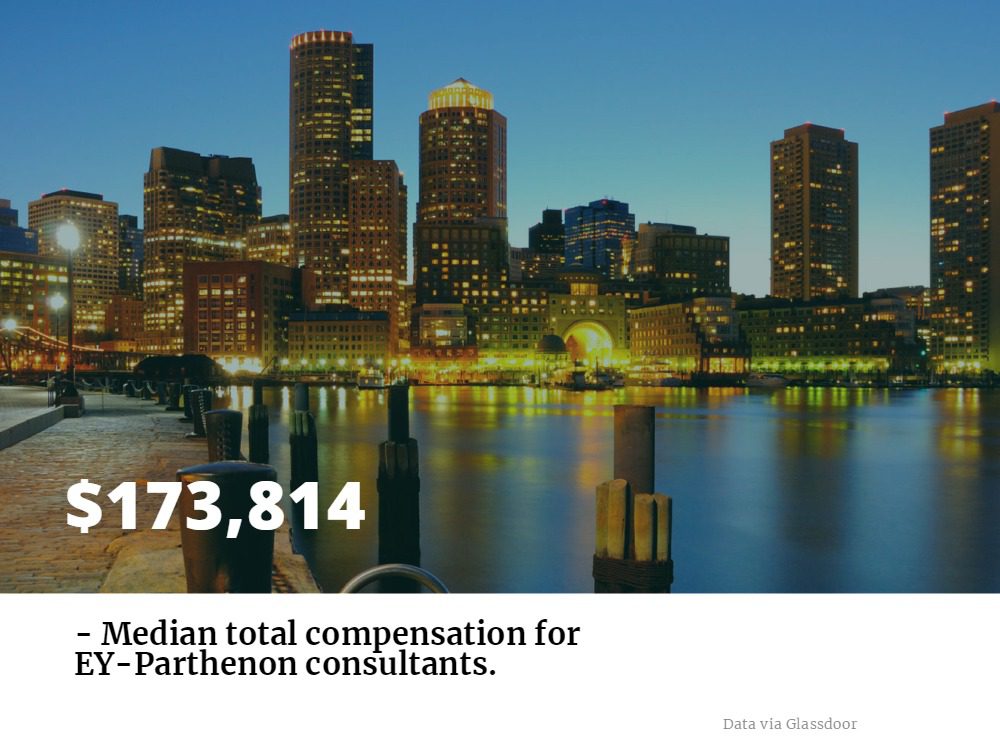
Landing The Job
Anyone can apply for a consultant role at EY-Parthenon, but the company also actively recruits at a number of undergraduate and graduate business schools. The MBA programs the company recruits from are spread throughout the world, and include some of the United States’ top programs, such as Harvard Business School, Kellogg School of Management, and the Stanford Graduate School of Business. The company also heavily recruits at international schools like INSEAD and the London Business School.
MBA students in their second year may apply directly for a full-time consultant role with the company, and first year students are eligible to apply for the summer consultant position. Any student attending a school that EY-Parthenon directly recruits from should check for the specific instructions on how to apply to these roles, typically through their university’s career services. The interview process for these schools typically takes place over two rounds, with the first round taking place on campus and second round interviews at the one of the various global Parthenon offices.
For more information on the company and job opportunities for current MBA students and graduates, check out the official EY-Parthenon MBA job page.
Inside Dean Matthew Myers’ Plans for the SMU Cox School of Business
On August 1, 2017, Matthew Myers became the ninth dean of the Southern Methodist University Cox School of Business. As the former dean of Miami University’s Farmer School of Business in Oxford, Ohio, Dean Myers comes to Cox with plans to build on the school’s current strengths and enhancing its offerings.
In a Cox Today article titled “The Dawn of a New Dean,” SMU Cox dives into Myers’ plans in a detailed interview. Here’s what he had to say.
Joining Cox
According to Myers, the most frequent question that he’s asked is, “Why Cox?” He explained that he was looking for an institution that knew its place in higher education and had an established identity. It was also important to love the city where the school was located, and he and his family were immediately drawn to Dallas.
“Dallas has a robust economy with people willing to invest in Cox and SMU,” he said. “You cannot have a world-class city unless there is a world-class university, and a world-class university cannot exist without a world-class business school.”
Investing in Teaching and Research
For Myers, there are many assets to the Cox School, and one of the greatest is its faculty and staff, in whom he plans to invest heavily to enhance the school’s research reputation.
“If you look at the top 30 business schools, the common denominator is excellence in research reputation. Teaching and researching complement each other—rather than detract from each other, as some believe.”
In particular, Myers will focus on improving research in the areas of global marketing and strategy issues, especially since crossing organizational boundaries has been a major theme in Myers’ career.
Investing Globally
Myers also hopes to bring his penchant for global business to SMU Cox. “We do not have a choice in business education but to be globally oriented, not just geographically,” he said. “The practical and relationship side of global business, including neighboring countries such as Mexico, should be a focal point.”
Myers even talked about how the NAFTA issue is salient for Cox both in terms of its research and topics of discussion in the classroom. This type of contemporary commentary about global issues is what he wants to bring to SMU Cox.
Investing in Students
Myers is also interested in enhancing the use of technology and innovation in the curriculum for each of the school’s degree programs. “That’s where the growth sectors are in the global economy,” he explained. “Cox graduates should have a place in those sectors after graduation no matter what their major is. It’s certainly something to focus on in the next five to 10 years.”
Dean Myers also plans to increase student exposure to the local and global business markets to better prepare them for the job market post-graduation. “Students have numerous choices in universities, and it’s very competitive,” he wrote. “The strategic relationships we have with the business community are important, as well as being attuned to growth opportunities. Many students want the option to work in entrepreneurial or nonprofit businesses, or they may want to work in London or Seoul with global firms.” SMU Cox will aim to provide opportunities that fit each student’s wants and needs.”
Investing in Partnerships
This limited development time also motivates Dean Myers to enhance SMU Cox’s partnerships with corporations and initiatives in the Dallas area. He explained that he’s interested in Dallas’ potential particularly for start-up incubators, venture capital, and entrepreneurship. “I want to understand how we can be involved,” he said.
Myers already feels that the Cox and Dallas communities are energetic, but he wants to enhance the strong academic relationships even further to leverage opportunities for students. For example, he noted that many top recruiting firms are cutting back to just a handful of university relationships, and he wants to ensure that SMU Cox stays in the mix.
“We want to make sure we are inside that play with all of the major companies, such as American Airlines and GE, and with startups, too,” he said. “We think we are there already, but it’s competitive and we have to modernize.”
About Dean Myers
Myers began his career in academia in 1997 after earning his Ph.D. in marketing and international business from Michigan State University. He became a professor at the University of Tennessee, where he led the Marketing and Supply Chain Management Department at the Haslam College of Business from 2008 to 2010. From 2010 to 2013, he served as the associate dean of executive education at Haslam. During that time, he was recognized three times as “the outstanding faculty member for MBA programs” and was responsible for launching the global Executive MBA program, which partners with ESSEC Business School in Paris and Central European University in Budapest.
In 2014, Myers became dean of Miami University’s business school. Of his appointment, he said, “The extension to the dean role was very fluid and natural. Giving the external nature of work and its greater connection to business, it was an area in which I could contribute.”
This article has been edited and republished with permissions from our sister site, Clear Admit.
Executive MBA Metro NY
Cornell Executive MBA Metro NY Program Structure
The Executive MBA Metro NY program is a 22-month, executive-style program offered on alternating weekends in New York City.
Curriculum and Experience
The Cornell Executive MBA Metro NY program features a comprehensive, integrated, general management approach that is designed for experienced professionals from a variety of industries. Students are introduced to a holistic view of business operations that emphasize the refinement of leadership and advancement of management skills.
The program, which is organized in four terms—each beginning with a week-long residential session at Cornell University (Ithaca, NY)—emphasizes core coursework in its first year, with advanced and strategic coursework incorporated into the curriculum in its second year. Students complete a total of six electives throughout the program, which are offered during the winter residential sessions and vary from year-to-year based upon student preferences.
The Metro NY program includes a Saturday overnight stay on class weekends, which creates an immersive format for extended networking, focus and collaboration, and engagement with classmates and faculty.
Class Profile
The Cornell Executive MBA Metro NY class features 70-75 students who are an average of 36-years old with an average 12 years or relevant work experience. Approximately 34 percent of the class comprises women students.
Careers
The Cornell Executive MBA Career Development team partners with each executive MBA student to develop a customized and strategically-designed professional development path that is focused on individualized objectives and needs. Once developed, a dedicated EMBA career coach will provide resources, tools, and programming to support these goals.
Tuition, Scholarships, and Financial Aid
Tuition for the Cornell Executive MBA Metro NY program Class of 2021 is $195,498 (USD). A limited number of partial merit-based scholarships are available for applicants.
There is no need-based aid available for Johnson’s graduate/professional students. There are federal student loans available to U.S. citizens and U.S. permanent residents (green card is required).
The Cornell Executive MBA Metro NY program is a proud member of the Yellow Ribbon Program. Formal submission of the Yellow Ribbon application and Certification of Eligibility (COE) are required for consideration.
Admissions
Applications are reviewed on a rolling basis. In advance of formal application submission, applicants are encouraged to complete a pre-assessment to see if they are a possible fit for the program.
As part of your formal application, applicants must provide:
● Resume
● Organizational chart
● Two required essays
● Official transcripts from all undergraduate and graduate schools attended
● Two letters of recommendation; one of the letters should be from an immediate supervisor
● $200 (USD) application fee
Application deadlines are as follows:
November 15, 2021: Priority Consideration
January 5, 2022: Priority Consideration
March 1, 2022: Regular Decision
May 15, 2022: Final Application Deadline
Interviews, granted by invitation only, are conducted shortly following the submission of a complete application. Decisions are typically communicated within two to three weeks of the interview. Classes begin late in July.
Just How Much Are Stanford MBA Grads Getting Paid?
Wondering what kind of pay day you can expect if you are among the select 6 percent of applicants who gain admission to Stanford Graduate School of Business (GSB)? Are you sitting down? Perhaps you should be, because the school’s 2017 employment report—released today—reveals record-breaking salaries for the third year in a row.
On average, last year’s graduates, now in their first year of post-MBA work, are pulling down an annual base salary of $144,455—a $4,000 increase over last year’s all-time high (median base compensation was $140,000, also besting last year’s by about $4,000). But it doesn’t stop there. Average signing bonuses, reported by 51 percent of the class, are also up—setting a new record at $29,534. (Median salary bonuses remained unchanged at $25,000.) And as if that weren’t enough, another quarter of the class reported other guaranteed compensation (OGC) surpassing last year’s all-time highs by a whopping $10,000. Average OGC for 2017 grads was $83,065, and median OCG was $50,000. The range was $6,750 to $450,000.
The GSB, in announcing these most recent employment statistics, pointed out that OGC will no longer be tracked by the MBA Career Services and Employer Alliance (CSEA) and that it began last year capturing an “Expected Performance Bonus” metric in its place. This measure includes both guaranteed and non-guaranteed cash compensation based on performance. Though the average and median EPB for the Class of 2017, at $71,946 and $35,000, were each lower than OGC figures, a full 65 percent of the class expected to receive such performance-based compensation, up from 61 percent last year—and substantially higher than the quarter of grads who reported OGC. The reported range for EPB was $5,000 to $450,000.
Stanford MBAs claim higher pay days than graduates of any other school, in part thanks to higher base compensation. Stanford’s median base—$140,000—surpassed that of Harvard Business School (HBS) ($135,000), the University of Pennsylvania’s Wharton School ($130,000), and the University of Chicago Booth School of Business ($125,000). Grads from both Stanford and HBS reported the same median starting bonus of $25,000, but the $50,000 in other guaranteed compensation reported by Stanford grads was double what grads at the school’s top East Coast rival reported.
Tech Less of a Draw Than in Prior Years
Bucking the trend at many other business schools—where increasing percentages of students are clamoring to enter the technology industry—fewer Stanford MBA Class of 2017 grads headed into tech. In what the school deemed “a rebalancing of the scales among the three top industries,” interest in technology dropped 8 percentage points—to a mere 25 percent of the class. Almost a third of the class—32 percent—headed into finance, up a point over last year. Consulting, too, gained four percentage points to attract 20 percent of the most recent class.
“Our leading employers span a wide variety of industries,” Maeve Richard, assistant dean and director of the Career Management Center, said as part of a news story announcing the latest employment statistics on the Stanford GSB site. “They represent organizations in such areas as consulting, finance, technology, consumer products, healthcare, and nonprofits. What they do have in common is work environments that offer the ability to make an impact with a focus on agency, career development, diverse challenges, and responsibilities.”
Indeed, a record-setting 411 organizations hired Stanford MBA students and graduates for internships or full-time roles this past year—up 7 percent over last year and 34 percent from six years ago. A whopping 95 percent of employers hired just one or two students—an indication of the breadth both of GSB employers and student interest.
Uptick in Women Headed into Private Equity and Venture Capital
“In addition, we observed that the number of women going to private equity and venture capital has nearly doubled since 2014,” Richard said as part of the Stanford GSB article. “While we do not disclose fine-grain gender detail and the numbers are still small, we see a definite widening of the cracks in the glass ceiling.”
It’s no wonder that Stanford GSB women would increasingly be looking to break into PE and VC, since those fields yield some of the very highest pay days. The highest reported base salary for the Class of 2017—$285,000—went to a graduate headed into venture capital. Median base salaries for both PE and VC were $175,000, $40,000 higher than for the class as a whole. And it was a graduate headed into a private equity analyst role who reported the mind-boggling $450,000 in other guaranteed compensation. The median signing bonus for PE—at $50,000—was also the highest in the class (on par with investment banking). Though it was a graduate headed into a marketing role who claimed the highest signing bonus of the class, $77,000.
Timing and Location of Offers
Stanford GSB reports full-time offer and acceptance rates at graduation and three months out from graduation—as mandated by CSEA standards. But in past years—as this year—the school has made a point of underscoring the fact that its graduates’ confidence in their ability to find the perfect job sometimes means they hold out longer in accepting their ultimate position than graduates from some other schools. That said, 92 percent of the Class of 2017 had offers three months out from graduation—up two points over last year—and 88 percent had accepted offers, a five-point increase year over year.
In terms of where geographically the most recent Stanford MBA grads wound up, the West was the winner—with 62 percent of grads choosing to remain in the region. This represents a 3 percent decline compared to last year. “Counter to assumptions, only 35 percent of these West region jobs relate to technology,” the school notes. “Finance represented 26 percent, and consulting represented 15 percent.” The Northeastern United States drew the second-most Stanford grads, 16 percent of the class. Another 11 percent took international jobs.
Also of note, 16 percent of the class launched their own startups upon graduation, up one percentage point over last year. Leading industries for these entrepreneurial students include software (15 percent), finance (11 percent), healthcare (9 percent), real estate (9 percent), and internet services (9 percent).
More Grads Seek Socially Responsible Roles
Another notable shift in these most recent employment statistics is the increasing number of Stanford MBA grads heading into careers in socially responsible roles or organizations. Thirteen percent of this year’s graduates answered yes to the question, “Have you chosen a socially responsible role in a private business?” That’s up from just 8 percent last year, when the question was first introduced.
Watch this space for an upcoming piece that will highlight several Stanford students who chose internships focused on social impact this past summer—a Clear Admit exclusive.
This article has been edited and republished with permissions from our sister site, Clear Admit.
Alumni Spotlight: Daryl Morey and Swapping Intuition for Analytics
In 2006, when Houston Rockets owner Les Alexander announced that MIT Sloan School of Management MBA, analytics expert, and relative NBA unknown Daryl Morey would eventually serve as general manager of the team, the basketball community was surprised, to say the least. A Hoopsworld headline, at the time, read, “Daryl Morey? Are You Serious?”
Though using quantifiable data to make business and strategic decisions across the majority of professional sports has become the norm, in 2006, it was far from standard practice, especially in the world of basketball. At the time, Michael Lewis’s book, Moneyball, was just three years old, and it only highlighted the use of analytics in baseball; perhaps the most straightforward team sport to quantify.
Now, 11 years into his career as a general manager, Morey’s use of analytics to guide NBA decisions ranging from draft picks, to whether a player should go for a three-point shot or a mid-range jumper (hint: take the three point shot) has made him a sports statistics pioneer.
Early Life and Career
While growing up in Medina, Ohio, Morey developed a love of sports. But, according to a profile in Slate, after reading articles written by alleged authorities making predictions for sports teams’ successes that proved way off base, Morey began to question the effectiveness of these experts. Shortly after this realization, Morey happened upon a book by the original sports statistics advocate, Bill James, author of the seminal 1977 book The Bill James Baseball Abstract. James’s data-based philosophy immediately resonated with Morey as the way to mold winning sports teams.
Though he knew early on that he wanted to devote his life to sports, Morey was uncertain of how to gain access to the exclusive business side of the industry. During his time at Northwestern University, Morey sent scads of letters to pro teams, begging for a shot at even the most low-ranking jobs. Each of these letters went unanswered. “So I decided at that point that I had to be rich. If I was rich I could just buy a team and run it,” Morey said.
It was this line of thinking that led the young midwesterner to apply to MIT’s Sloan School of Management. After earning his MBA from MIT in 2000, Morey pursued a career in consulting. Eventually this led to a job working for the Boston Celtics. It was during this time that Morey began applying a statistical model he had developed to size up amateur players to the actual draft. Just a couple of years later, Morey was approached about a managing position for the Houston Rockets, where he has now served as general manager for eleven seasons and has just signed on for an additional four years.
Philosophy and Contributions
At just 21-years old, Morey adapted Bill James’s Pythagorean Expectation, a formula used to predict how many games a team would win, to basketball. “I would have never guessed that you could adapt the Pythagorean to basketball,” James said.
In basketball, Morey is partially credited with normalizing the use of analytics in player acquisitions, as well as approach to the actual game. Under his leadership, the Rockets acquired franchise cornerstone James Harden in what is, in hindsight, already considered one of the more lopsided trades in basketball history. Morey was also instrumental in starting the annual MIT Sloan Sports Analytics Conference, a forum wherein students and professionals can exchange views on the role of analytics in the sports industry.
When asked about his thought processes in Northwestern Magazine, Morey said, “You don’t fool yourself, you take a lot of chances, you cut your losses quickly. That’s all you can do.”
Like the slow-crawl of acceptance sabermetrics toiled through in Major League Baseball, Morey’s analytical imprint on the NBA has routinely drawn the ire of some of the game’s most notable figures, including Hall of Famer, “golfer,” and Inside The NBA host Charles Barkley. In 2015, Barkley routinely chided `the Rockets’ paltry defensive efforts, noting Morey’s tactics of bringing in players seemed fairly basic.
Just two years later, however, and the Rockets are currently riding a 10-game win streak and sit atop of the vaunted Western Conference, with Harden earning potential MVP praise and point guard Chris Paul commanding one of the league’s best offenses. And Morey’s analytical emphasis on three point shooting and pick and roll sets, dubbed “Moreyball,” has never been more prominent. The Rockets lead the league—by far—in three-point attempts per contest, launching a blistering 43.2 per game. For context, the team with the second most three-point attempts per game, the Brooklyn Nets, take 33.8 per game—nearly 22 percent less than Houston.
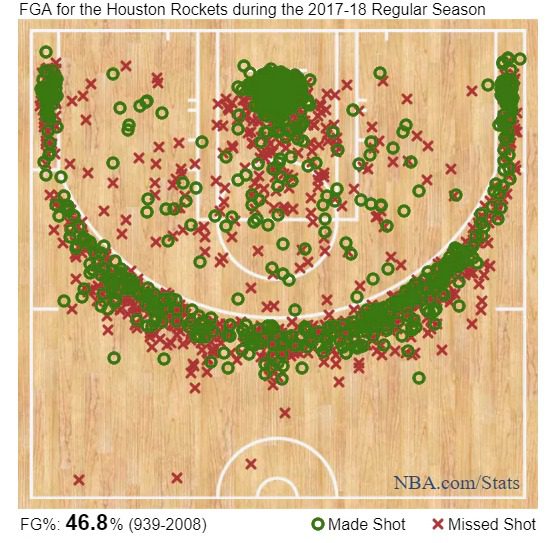
Stats via NBA.com/Washington Post
The Rockets’ analytical trend may seem extreme, but the rest of the league is still taking notice. The average three point attempts taken per game, nearly a quarter of the way into the 2017-18 season, is the highest ever at 28.7 attempts per game per team; and those figures have gone up every year since 2012. If Moreyball remains a staple of the NBA offense, expect that figure to be broken again in 2019.
Other Pursuits
Morey has a love of musicals, and even proposed to his now-wife Ellen before a production of Grease. It makes sense then that the man the New York Times called a “wizard in the field of quantitative analysis,” has chosen to devote his time to producing a musical. The show, “Small Ball,” is slated to debut in 2018.
Made in Italy and NYU Stern: James & Salvatore Ferragamo
When it comes to Italian high-fashion, names like Gucci, Versace, and Prada often come to mind. These companies, known for their quality products and timeless brands, are staples in both the fashion and business communities. Salvatore Ferragamo S.p.A., another Italian fashion company, is notable for not only their quality leather and fine wine, but also for their leadership, namely twin brothers and NYU Stern School of Business MBA graduates James and Salvatore Ferragamo.
All in the Family
James and Salvatore followed the footsteps of their father and company CEO Ferruccio, and grandfather Salvatore, who founded the brand in 1928. The company’s current structure features each of the founder’s six sons and daughters with a role on the board of directors, with other relatives also taking jobs within the organization.
However, the Ferragamo clan decided that only three members from the family’s third generation should be involved in the family business. These three members were required to have a university degree, an MBA, three years of working experience outside of Ferragamo, and English and IT skills. James and Salvatore accepted this challenge: Both graduated from NYU’s Stern School of Business with a BS in 1993 and again with an MBA in 1997.
What have the two Ferragamo heirs and Stern MBA alumni been up to lately? Both have been utilizing their strengths to push the Ferragamo brand to new heights in different ways.
Expanding “Made in Italy”
James is currently the Director of Women’s and Men’s Shoes and Leather Goods for the Salvatore Ferragamo Group. His responsibilities include overseeing all categories from bags to belts, with a focus on shoes. He briefly worked at Goldman Sachs before completing his MBA in 1997 and joining the family business. James was the first member of the third-generation Ferragamo’s to enter the business.
According to James, a big part of innovation is collaboration. Since 2010, all leather goods collections have been created side by side with the brand’s creative director, Massimiliano Giornetti. Together, James and Massimiliano have pushed Ferragamo into modern territory, while still respecting the brand’s heritage.
YOU MAY ALSO LIKE: Supply Chain Management MBAs: The Best New York Programs
“Together, we need to communicate Ferragamo’s creativity,” James told the South China Morning Post. “For Massimiliano, he pushes on the accelerator of creativity and creates novelty with the ready-to-wear. My role is to try and make sure that we have quality and never compromise on it.”
Ferragamo has always prided itself on being “Made in Italy” and James says that will remain the brand’s headlining message, even as it expands into new markets like China. “No matter what, all our products will always be made in Italy,” he said, doubling down on his decision to keep all production inside of Italy in the near future. “My father had a very rigid point of view on this. Italy, to us, represents a certain uniqueness, and people love this idea of artisanship.”
Resurrecting Il Borro
Instead of following the career trajectory of the rest of his family, Salvatore followed his true passion: wine.
“[My brother James] likes fashion, and I like wine, so it worked out perfectly,” Salvatore told The Drinks Business.
Since graduating from Stern’s MBA program in 1997, Salvatore has been tasked with expanding Ferragamo’s brand portfolio into wine and agro-tourism at Il Borro villa. The Ferragamo family purchased the Tuscan vineyard in 1993 and Salvatore has led efforts to restore the estate and innovate the wine production business, while always sticking to the family’s commitment to being “Made in Italy.”
“Fashion and wine are both a question of lifestyle, personal taste, and sensibility,” Salvatore told Wine Enthusiast. “When I was growing up, I was surrounded by a spirit of fine craftsmanship and careful attention to details that are the hallmarks of ‘Made in Italy.’ My family has always believed that this approach is the best way to express creativity, tradition and quality, and it’s true in both fashion and wine. For example, all of the grapes that go into our wines are carefully chosen by passionate hands that give each bottle its own character.”
In September, Salvatore revealed that Il Borro is producing an amphorae wine made with Sangiovese with the skins kept in contact with the clay vessel for one year. The clay is sourced locally and is made by a local amphorae maker. The wine “Unlike French oak, amphorae doesn’t give the wine notes of tobacco or spices, it focuses more on the fruit notes of the wine,” he said. Salvatore added that he is also experimenting with “a secret project” — a Chardonnay made with the same method.
Reflecting on NYU Stern
In 2006, James and Salvatore invited a group of Stern alumni to their flagship Fifth Avenue store. At the event, the Ferragamo twins were asked how studying at NYU Stern and working in New York helped them as they entered the business world.
“NYU helped me to balance my professional experience with my academic experience,” James said. “Living and working in New York City provided the opportunity to understand the practical application of what I learned, as both a graduate and an undergraduate, whether it was about finance, fashion, marketing, or advertising.”
“Studying in New York gives you the unique opportunity to learn in the business capital of the world and to be in contact with people from different countries, cultures, and businesses,” Salvatore said. “This is very important as I am promoting Il Borro estate worldwide, and it is crucial to understand, recognize, and respect different cultures when entering into any type of global business relationship.”
Fashion and Future at Stern
Recently, alongside the new Tech MBA, the Stern School of Business introduced the forward-thinking Fashion & Luxury MBA, which features several high-profile figures on its advisory board from the likes of Dolce & Gabanna, Tiffany & Co., Nike, Vogue and more.
For more information on the NYU Fashion & Luxury MBA, click here.














